One of the first standing desk brands we had the opportunity to review was the Uplift Desk v1. It was recently updated to the Uplift v2. Since this change, we’ve received a ton of requests to provide an updated review.
Today, we will be taking a closer look at the v2 product. Because the v1 was one of the first reviews we did, it wasn’t as complete as others done later; the comparisons were in-depth, but the review was lacking. This new review follows our updated format, including all the details we look at when reviewing electric standing desks. Let’s take a closer look to find out what we’ve learned.
Full Disclaimer: We are an office furniture dealer and sell some of the electric adjustable desks we review. To learn more about the products we sell, our review process and why you can trust us, please visit: Why we’re different. Who is BTOD.com and The Breakroom Blog?
Uplift Desk v2 Review Snapshot
Pros
- 7 year warranty on frame
- 355 lbs. weight capacity
- 6-way accelerometer collision avoidance system
- Large in stock surface collection
- 1.41" per second adjustment speed
Cons
- No traditional cross support system
- Low quality electronics
- Excessive grease on gears
- Dated motor system
- No overload protection system
Uplift Desk v2 Review Links
– Specs / Pricing / Features
– Assembly Process
– Stability Testing
– Electronics
– Column, Foot and Frame
– Motor and Gears
– Glide Systems
– Testing The Specs
– What I Like
– What I Don’t Like
– Final Thoughts
OEM Manufacturer
The Uplift v2 is currently manufactured by a popular Chinese company, JieCang Linear Motion. This is the same manufacturer used for the Uplift v1 standing desk. They have been producing linear actuators for hospital beds and accessories since early 2000. In 2011 they saw an opportunity to produce adjustable bases, using their linear actuator technology within metal desk frames. They are one of the leading Chinese manufacturers of electric standing desks.
Uplift Desk History
The Uplift desk brand was introduced in 2013. The original version of the desk was the Uplift 900. It was then changed to the Uplift v1. TheHumanSolution.com has made multiple changes to the product, including a switch from the T-base to the C-base now being used. They have also updated their foot design, to include an aluminum foot.
Product Specs (per UpliftDesk.com)
Height Adjustment Range: 25.5” – 51.1”
Travel Speed: 1.57” Per Second
Noise Level: 50 Decibels While in Motion
Weight Capacity: 355 lbs.
Adjustable Width Base: 42.25” – 70” W
Adjustable Foot Glides: 3/8” Adjustment
2025 Pricing
As I was finishing this review, the prices on the Uplift v2 desk changed. Below is a general breakdown of prices for various sizes of bamboo and laminate desks.
| Desk Size | Pricing |
| 30” x 48” | $659.00 |
| 30” x 60” | $759.00 |
| 30” x 72” | $829.00 |
| 30” x 80” | $919.00 |
Features
- Two stage legs (three piece) for 26” overall adjustment range
- Telescoping base to adjust to multiple width tops
- 48 mounting hole system in under desk cross support
- 6-way accelerometer collision avoidance system
- 15 year warranty on all parts including electronics
Packaging
The packaging for the Uplift v2 has changed some compared to the Uplift v1. Instead of including all components for the frame in one box, the have split it into two boxes now. This has reduced the weight of the large box and made it a bit easier to handle.
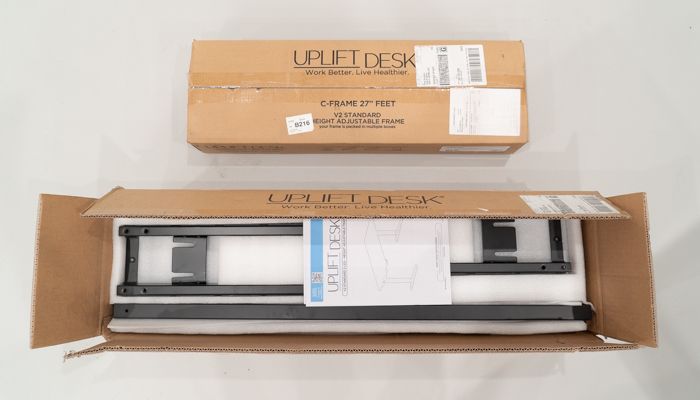
Assembly (30-90 Minutes)
The assembly of the Uplift v2 is on par with other JieCang frames we’ve assembled. This includes the Uplift v1 that we assembled back in 2017. The actual assembly process hasn’t changed between the two versions over the past two years.
The same pain point exists with some of the hardware being difficult to insert and tighten. Using the allen wrench, included, can be time consuming with the quantity of bolts required to complete the assembly of the frame. If you have a bit set, I would recommend using a cordless drill to speed the process up significantly.
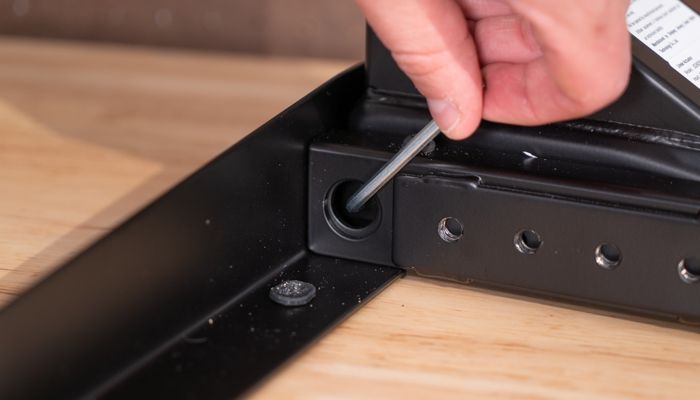
Depending on the amount of wires you have with your desk, the wire management process could take longer than the actual frame and top assembly. This is common with most standing desks. The 30-90 minutes of assembly time does not include this portion of the setup.
Uplift v2 Stability
One of the things that we’ve been getting asked a lot, since the release of the Uplift v2, is how the stability compares to the v1. A lot of this stems from claims from Uplift Desk that they’ve improved the stability of the v2 with the tightening of tolerances between the columns (metal legs). Based on our own testing of four different Uplift v1 and v2 frames, there hasn’t been an improvement of tolerances between the tubing. The tolerances are still within the same .10 – .15 mm we’ve seen from this product in the past.
Additional confusion likely exists because of the release of the v2 commercial product. The v2 commercial product now includes the use of a traditional cross support between the legs. This commercial frame also includes larger tubes, that are made from a thicker steel. Overall, the commercial design was built to improve stability and it did. It is not the same product as the standard v2 we are reviewing today and the stability for each is quite a bit different.
Because there were no real changes to the v1 and v2 frames, the stability of the products remained virtually the same. With natural variances existing within the steel tubing used on the desks, the stability between two frames can vary slightly. Using the WobbleMeter (what is the WobbleMeter?), we were able to verify these findings. There were no noticeable differences between each of these frames.
WobbleMeter Testing v2
If you would like to see the pictures and videos of us testing the v2 on the WobbleMeter, please visit the WobbleMeter Uplift v2 testing page. Below is the deflection score range guide for the WobbleMeter. How these results impact your experience will depend on your sensitivity to wobble and rocking motions.
WobbleMeter Score Range Guide

0-20 = Excellent Stability
Almost all of the desks tested at sitting height will score between 0-20. This is our baseline for excellent stability since most standing desks provide excellent stability at their lowest heights. Users in this range will not notice motion.
21-30 = Very Good to Good Stability
Between 20-30, most users will not notice the small amount of motion in this range.
31-40 = Good to Fair Stability
Between 31-40, some users may begin to notice the amount of motion in this range. This is especially true the closer the score is to 40.
41-50 = Fair to Bad Stability
Between 41-50, most users will notice the amount of motion in this range. This is especially true the closer the score is to 50.
51-60+ = Very Bad Stability
Between 51-60+ all users will notice the amount of motion in this range. This is especially true for scores that are above 60.
WobbleMeter Results for v2 Frame
Overall Wobble (Side to Side) Deflection Scores
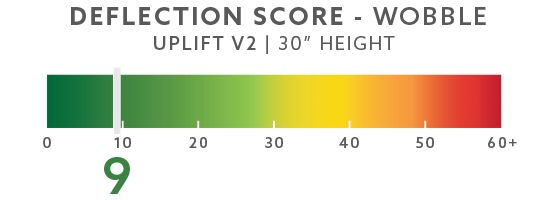


Overall Rocking (Front to Back) Deflection Scores

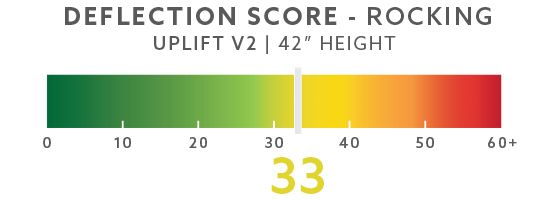

Uplift Desk v2 Electronics
With the change from v1 to v2, I had expected to see some significant changes in the control systems electronics. We’ve had close to 15 different versions of JieCang frames in our offices over the years, so I’ve become very familiar with their products. The Uplift v2 had a couple of changes with their latest control box, but they were subtle and could easily be missed.
Overall, the look of the circuit boards is similar to previous iterations. They are still using the two-board system, with a mass-produced power supply system. There is a significant amount of silicone caulk used to hold components in place as well. This is a cheaper way and based on the price point for the product, it’s no surprise they are still doing this. We’d like to see a cleaner single board setup for the brains of the system, similar to that of VariDesk ProDesk Electric.
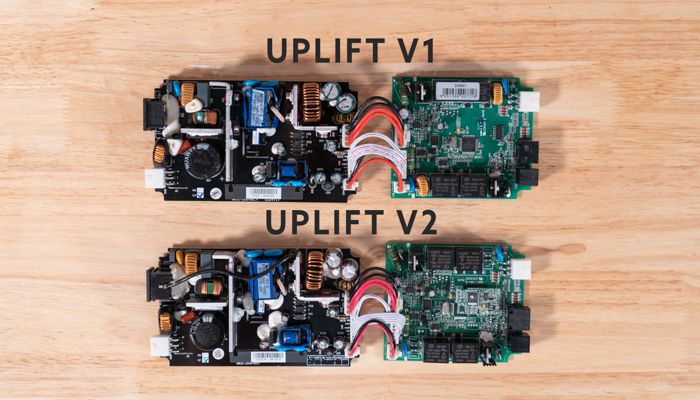
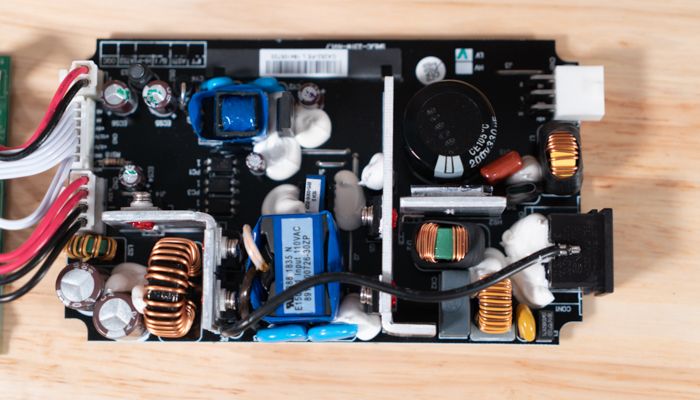
The power supply is almost exactly the same, with one small change; they have decided to add a grounding wire to the system. With this change, they have updated the power cord to include the grounding wire and made improvements to the quality of the power cord when compared to the v1.

On the second board, there was an additional change as well. If you look closely you can see the second small board that was added. This is JieCang’s new 6-way accelerometer system, used for a more sensitive collision avoidance system. Moving this board off the main is a smart choice. We’ve had our own experience with the gyro system in the VertDesk v3 and moving it off the main board improved performance.
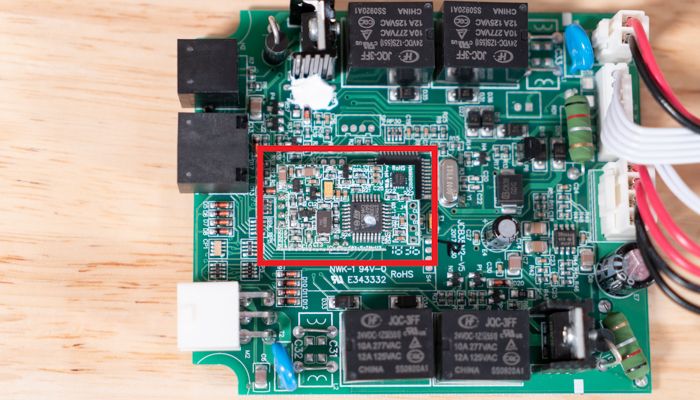
Column, Foot and Frame Build Quality
At first glance when pulling the v2 from the box, things looks pretty status quo. The columns and foot were exactly the same as the previous versions of the Uplift Desks I’ve tested. Just to verify, I brought out two sets of columns we had in storage.
The only real change that I noticed was within the upper frame. Uplift Desk has decided to add mounting holes to their upper cross support system. Their website mentions the ability to mount accessories like CPU holders, keyboard trays and even hammocks. They also changed to a recessed set screw in the expandable cross frame. This provides a bit more of a cleaner look.
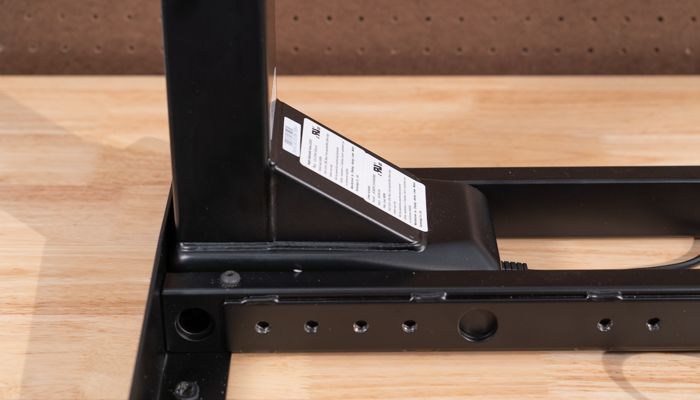
Without experience using this system, I can’t really comment on how functional it is. If it works, it could definitely be a good thing, since mounting space underneath standing desks can be a limiting factor with the crossing frame.
The overall finish of the column and upper frame is good. JieCang does a good job with their welds on the tubing used and the paint finish. Uplift is still using the same molded foot design, which has a nice look and gives them a slight aesthetic advantage over other JieCang products.
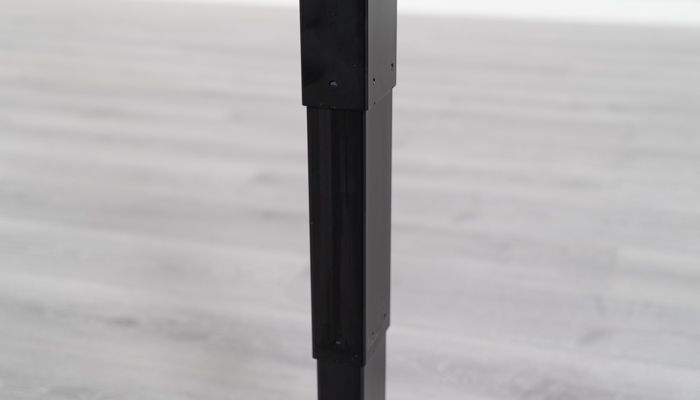
One thing I’m surprised hasn’t changed with their frame is Uplift still doesn’t use a threadlocker such as loctite, to help with keeping bolts in place. Alternatively, you could use locking washers. Either way, these desks have a ton of vibrations as they move up and down. Over time, the bolts naturally loosen, which will create stability issues. My suggestion would be to add these on your own after buying the frame.
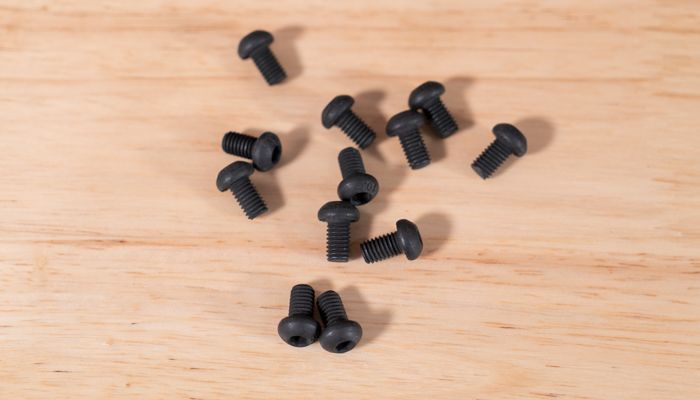
Motor and Gears
Pulling the columns apart on the Uplift v2, one of my favorite parts of this process, was a bit disappointing. Honestly, I had expected to see a change here, specifically with the motor. Our update to the Fully Jarvis review on 11/27/17, revealed a change to an improved motor. The Uplift Desk v2 was the same as the v1.
The v2 motor still had the exposed gear and worm drive, with excessive lubrication issues. The external DC motor control board was the same as well, using some type of silicone caulk to hold the wires in place.
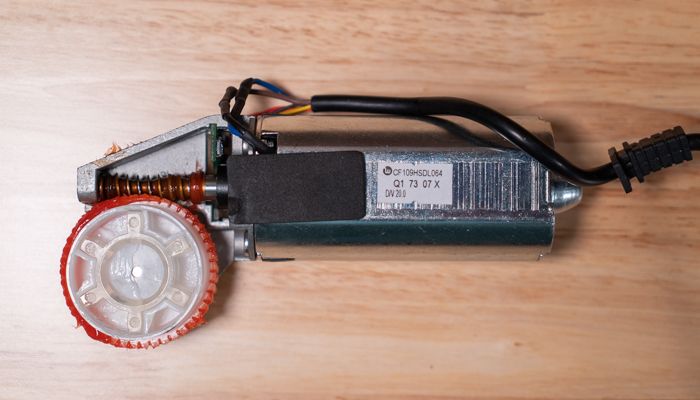
Having reviewed the Fully Jarvis, we know that JieCang made improvements on certain versions to this part of their desk. Internalizing the gear and worm drive on the motor was a nice change, helping to reduce the potential for contaminants such as dust and dirt from entering. JieCang also moved the motor control inside the motor housing for the Fully Jarvis update.
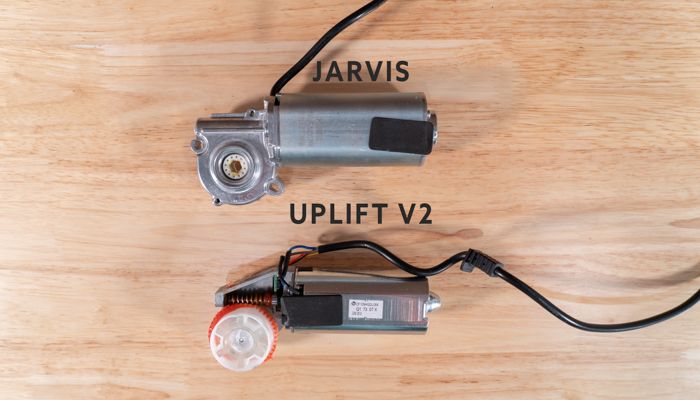
The gear system found on the Uplift v2 was unchanged as well. This is another area that could use some improvement. The same excessive yellow lubrication is found throughout the gear as you extend it. While we wouldn’t expect to see the level of quality of a Linak or Ketterer gear at this price point, something closer to the Aoke desk would be an improvement.
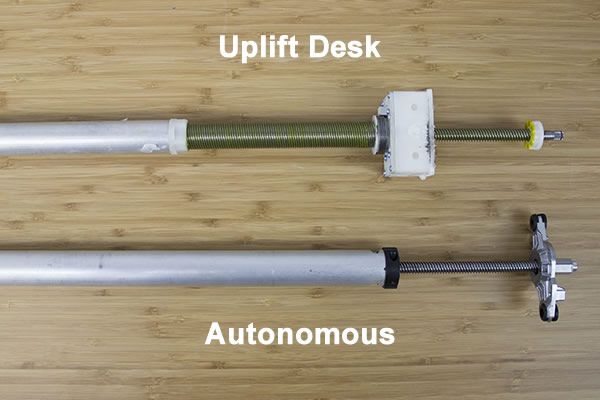
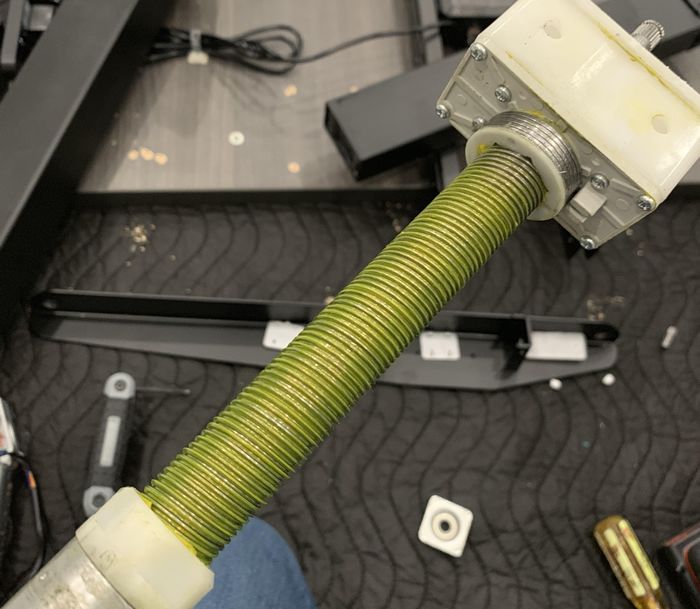
Glide Systems
Like the rest of the columns, the glide systems on the Uplift v2 remained unchanged. While the material type of the plastics used for the JieCang product are unknown, we found similar issues with the glides on the v2. With minimal cycles, they had already shown a fair amount of wearing with grooves starting to develop in the glide.
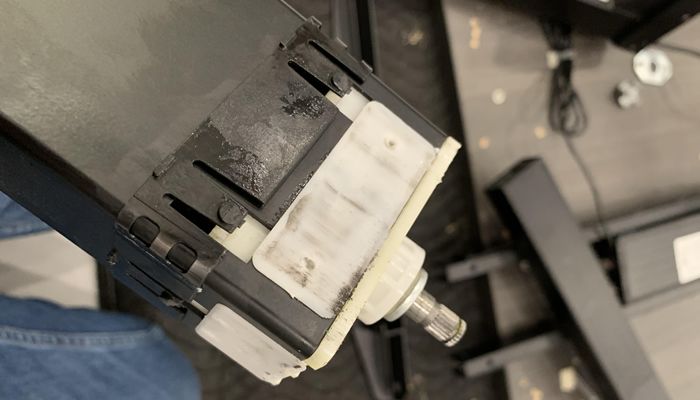
On a positive note, the v2 I pulled apart didn’t have as much white lubrication as the previous models. Because of their history of inconsistencies here, it is hard to tell if it was by chance or an intentional change. If you’re worried about the aesthetics of this, my suggestion is to look at the silver or white frames. They do a better job hiding lubricants that can come from the glides.
Warranty
The warranty for the Uplift v2 frame is straight forward. Full coverage on all components for a period of 15 years. The surfaces are covered for a period of 5 years.
Weight Capacity Testing
What I like
15 Year Warranty
The Uplift 15 year warranty on their frame is solid. This is a prime example why competition between brands can be a good thing for the consumer. With Fully and Uplift offering such similar products, they realized they needed to differentiate themselves with a better warranty. Ultimately, they ended up matching each other with 15 years on the frame.
Weight Capacity
The weight capacity of 355 lbs. will be more than enough for most users’ requirements. The typical load requirements for an office would be closer to 150-200 lbs., so there shouldn’t be any capacity issues. We’ve found that Uplift v2 stays consistent with various load as well.
Collision Avoidance System
The new 6-way accelerometer system worked well with the limited use we’ve had testing it. It was more sensitive than the previous software driven system and should have fewer issues with binding problems that are likely to develop in the columns over time.
Top Selection
The Uplift v2 comes with a nice variety of top material options. The Uplift Desk probably offers one of the best in stock selections, when you look at the different materials they have on hand. In stock options include: Bamboo, Laminate, Eco Powder Coat and Rubber Wood options.
What I don’t like
No Traditional Cross Support
Even though the Uplift v2 is the most stable two leg standing desk we’ve tested without a cross support, it still doesn’t compare to the v2 commercial. The wedge system is the clear solution for desks that don’t want to have a cross support, but if you want rock solid lateral stability, you need a cross support.
Low Quality Electronics
Like other JieCang products we’ve tested, including the Uplift Desk v1, the electronics in the control box are subpar. The use of mass-produced power supplies, with silicone caulk to hold components in place, is a cost cutting solution for standing desk manufacturers.
Excessive Grease on Gears
We’ve talked at great length about the importance of quality gear systems. Unfortunately, the Uplift v2 comes with the same gears that were in previous versions. The amount of yellow grease on the gears is disappointing, as well as the quality of the gear itself.
When compared to higher quality gears, the difference is obvious. Even products from Aoke, the OEM that makes the budget Autonomous desk, has done a better job here.
Dated Motor System
Seeing the motor that came with the newest version of the Uplift Desk, I was surprised they didn’t make a change here. JieCang has had a better solution available since 2017, which they have been selling to Fully Jarvis desks.
The external gear and worm drive on the motor are just asking for problems. Pair that with even more excessive grease that is all over the DC motors controller and its apparent why the change to the newer system would be a major improvement.
No Overload Protection
The Uplift v2 can lift a ton of weight, but there is no way to know for sure if you’ve put too much on the desk. The Uplift Desk v2 should have an overload protection system in place to avoid overloading the desk and breaking internal components. If you notice a significant drop off in speed and the motors getting a lot louder, I would suggest stopping the movement of the desk.
Bottom Line
There has been quite a bit of interest around the update from v1 to v2 for the Uplift Desk. While the introduction of the v2 Commercial was a big change for the Uplift brand, the standard v2 without cross support didn’t get too many changes. The most noteworthy changes were the introduction of a 6-way accelerometer for collision avoidance, a small increase in lifting speed and the 48 mounting points in the upper cross support.
The Uplift v2 is still a good value for the price, with a solid warranty and plenty of in stock surface options. If you’re looking for high quality components such as electronics, gears and motors, this isn’t the best option in the class. For better stability from Uplift Desk, we would look at the Uplift v2 commercial.







Sharon O’Bryan
I purchased the higher end of options with my UpLift Desk and initially I loved it but when time came for me to get to work I found that faulty Keyboard Tray design caused notable damage to my $830 desktop AND the company did not stand behind their product.
I ordered the Switch Ultra Thin Keyboard Tray (“the tray”) and the “wheels” at the top of the tray would hit the front of the desk top and caused unsightly damage. I followed proper protocol to notify and discuss the issue with the company and filled out their Warranty claim form (which specifically mentions scratches). I submitted photos of the installation which exactly matched the written and video instructions. I was told they concluded that the damage was not covered under Warranty due to “customer caused damaged due to improper assembly of the keyboard tray system”. This is absolutely not the case. I spoke to the company representative about this false claim and she indicated the reason was the “Track Spacer” was not installed and we used the 11” track instead of the 21” track. Neither the instructions nor the video in any way indicate that this is a requirement nor does it mention risk of damage to desk if the 21” track and Track Spacer is not used. The instructions specifically say this is OPTIONAL. I sent the company representative the instructions that came with the keyboard tray and the link to their own video. I am not going to allow the company to get away with this. Clearly they know about the issue with their keyboard tray mechanism and all they have to do is adjust their procedures and videos to properly document this; I do not want to go through this and I am sure no other customer wants to go through the complex process of taking apart and reassembling this desk! I will not allow the company to get away with this. I paid a premium for this desk and it looks terrible due to their design issues and an extremely low cost solution of changing their documentation for pre and post sale. The Track Spacer is very bulky and plastic that makes the desk look cheap. Such a shame for such a promising product.
Konstantin
After doing a very extensive research and reading a lot of reviews online I settled on purchasing Uplift desk. I was so excited to finally have the standing desk and was looking forward to this new experience.
I purchased the desk on December 10 received everything in 3 separate packages arriving within a week of purchase. It took me about 2 hours assembling the desk including neatly arranging cables etc. When I plugged in the desk I was so excited, but unfortunately my desk was dead on arrival. I tried every possible reset combination, but still received error code E08.
My next step was to call Customer Service. It took me about an hour with them, but I was still receiving this error code. After they exhausted all possible options, they sent me to warranty department. That department just sent me replacement control box and one leg.
Another week passed by and I finally received a new control box and a new leg. To my complete disbelief the problem was still the same after I exchanged the control box and tried to exchange each leg individually.
Another call to customer service and another hour on the phone and still no working desk. They sent me back to warranty department that does absolutely nothing but sending more replacement parts.
So far it has been almost one month since my original order and I have no desk. I can not even use it as a regular desk because it sits way to low. I’m at the point of calling my credit card company and canceling this transaction. It has been a very frustrating and disappointing experience with this desk. Definitely not something you expect from a company that position themselves as best product on the market.
Customer service is also not top notch. Every time I call them, it takes at least 30 min to connect to the live person. After I was connected, the customer service rep did not even attempt to help me, but sent me straight to warranty. By the way warranty department communicates only by email (no live person) and mostly just keep sending replacement parts.
Three weeks later and 6 hours of my time I finally received the parts that actually worked and was able to use the desk.
I attempted to call Uplift and asked to compensate for my time and trouble. They offered … $50. What an insult.
At the end, I do not recommend this desk and this company. Overall mediocre customer experience and dead on arrival product. There are other options on the market for less. Do not be fooled by marketing reviews made by multiple sites. Now I’m 100% sure that all of them are paid advertising and not honest reviews.
Sharon O’Bryan
You are not alone. Initially I was very pleased and excited about the product but when trouble started due to their design flaw (see my review) I found that they were not the company they are trying to make themselves out to be. If I had it to do again there is no way I would spent $2,500 on a desk with this company. It is a shame because they could be so close but lack of adequate QA and critical omissions in their documentation and videos will make this company short lived. Like it or not – bad experiences voiced in social media will kill a company.
Patrick
It looks like Uplift increased their warranty period a few months ago, with an odd start date, for orders placed starting July 22, 2020. Looks like it’s gone from 7 to 10 years for the frame/motor/electronics and it specifically mentions 5 years for desktops. What kind of issues might occur with laminate desktops over 5 years?
https://www.upliftdesk.com/warranty/